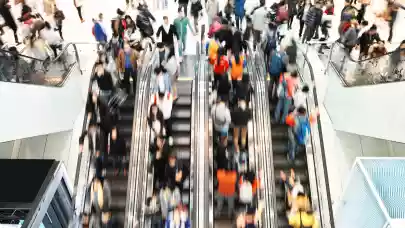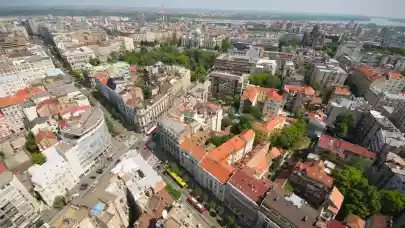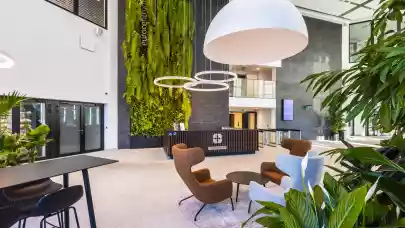
The great majority of shopping centres in the Czech Republic should reopen on Thursday 3 December. The footfall and revenue figures show that customers have not given up on visiting shopping centres in the long-term perspective or changed their shopping habits dramatically. Following the reopening after the first wave of the corona crisis, both performance indicators grew again, and revenue even exceeded last year’s figures in a year-on-year comparison. The impact on footfall and turnover was lower in the second wave, with footfall slightly growing in recent weeks. Considering that Christmas is coming, we can expect customers to return to shopping centres quickly as soon as they are allowed to, resulting in an exceptional increase in footfall and revenue.
Cushman & Wakefield evaluated the turnover and footfall figures for the shopping centres in its portfolio in Prague and in the regions from January to October in 2019 and in 2020. They found that the decrease is always directly related to the ongoing restrictions of operation, and is not of a long-term nature: whenever possible, customers return again. The initial concerns to the effect that people would change their shopping habits, do most of their shopping online and avoid coming to shopping centres for safety concerns have not been fully confirmed. Systems in many online shops are already hitting the limits of their capacity and they no longer accept orders, which is one more reason why customers are looking forward to going to brick-and-mortar shops, and an advantage for them.
"The benefits of shopping in brick-and-mortar shops are undisputed and customers definitely do not want to give them up. In addition to practical aspects such as the opportunity to take a good look at the goods, try them and bond with the product or brand, shopping is also fun and a way to spend leisure time for many customers. It doesn’t have to be all about shopping: visiting catering, entertainment and cultural concepts is an important part of shopping at shopping centres. Those concepts are an integral part of the retail environment where the various functions and concepts complement each other excellently,” Jan Kotrbáček, Partner & Head of CEE Retail Agency team, Cushman & Wakefield commented.

Jan Kotrbáček
Head of Retail Agency CEE
Cushman & Wakefield
A rapid return to normal followed the first drop
The great majority of shopping centres showed a sound growth in the first two months of this year: January revenue was on average 8 per cent higher in year-on-year terms and February revenue was 10 per cent higher, while footfall was comparable to or higher than last year. The closure of most shops in March brought about an unprecedented drop, which reached its lowest point in April: revenue decreased 85% year-on-year, with footfall decreasing just slightly less than that. April results were the worst because the restrictions lasted for the entire month, whereas in March it was a half of the month and in May it was one third.
Revenue was just slightly lower year-on-year in June, and it was even higher in July and August than it had been in the same period last year: for example, shopping centres in Cushman & Wakefield’s portfolio grew by 3 to 5 per cent. Throughout the summer, footfall remained on average 15 per cent lower than in the previous year, but in combination with the increased revenue, this means one thing only: people would come to shopping centres less often but they spent more money at once during their visits.
Michal Soták, Partner, Head of the Capital Markets team in the Czech Republic, Cushman & Wakefield added: “Most shopping centres managed to respond well to the unfavourable developments and set up measures that resulted in a return to pre-crisis figures in the long run. They managed to make up for the previous restrictions during the summer months, which gives hope that this will be the case following the currently prepared reopening as well.”
Growth can be expected again following the second wave
A quick return to the usual values of shopping centre performance indicators can be expected after the release of the current restrictions. In addition, the drop was not as big this time as it was during the first lockdown: if we compare the trend in turnover and footfall during both waves of the pandemic, the impact on both parameters is lower in the second wave:
- Shopping centre footfall decreased by 71% year-on-year in the period from 15 March to 10 May, and by 65% in the period from 22 October to 22 November. The conditions were not entirely comparable, though: in addition, sales after 8 pm and on Sundays were forbidden during the second wave.
- The overall decrease in revenue during the second lockdown will be known once the data for November is available, although the current figures suggest that it should be less pronounced than during the previous lockdown.
In addition, we have seen footfall in shopping centres grow continuously despite the restricted operation in the course of last weeks. This also shows that people are returning to their former shopping habits, and visiting shopping centres is a major part of their habits. This applies even more in the pre-Christmas period, which is just beginning – so, along with the planned reopening, we expect exceptional growth of both footfall and revenue.
“Christmas is a key period and the culmination of the shopping season for retailers. As such, opening the shops for customers is definitely a favourable and crucial step for the recovery of the retail sector. The sooner this happens the better – not just in terms of ‘salvaging’ retail revenue this year, but also for shoppers’ safety. If the great number of visitors to shopping centres and high street shops, who we expect to come during the Christmas reopening, is distributed over a longer period of time, the concentration of people will decrease, which is obviously a good thing. This is also why we are discussing the possibility of extending the opening hours into the evening with our tenants,” Jan Kotrbáček said.
Safety concerns are not substantiated
It is conceivable that, similarly to the summer, customers will come to shopping centres less often, albeit for large one-time shopping trips. As a result, revenue will most likely grow faster than footfall as people will still tend to avoid frequent stays in areas with higher concentrations of people.
Shopping centre owners and managers along with shop tenants assure us that customers have no reason for concerns: thanks to the use of technologies, emphasis on sanitisation and safety options, centres are among the safest shopping destinations. For example, technologies at entrances or car parks allow for precise monitoring and, if required, reducing the number of visitors; and strict regulations ensure a high standard of cleanliness and hygiene, frequent cleaning and sanitisation of shared areas, high-quality sanitary amenities and filtered air exchange. Professional security guards (coordinators of people moving in the facilities) watch over safe movement in shopping centres to ensure social distancing and prevention of people gathering.
“During the first wave, we adopted measures maximising visitor safety and comfort in the shopping centres we manage in accordance with all legal requirements and beyond, and we are continuously responding to government regulations and recommendations during the second wave. We are prepared to provide surveillance over the number of visitors in common areas and prevent their gathering. We are happy that our visitors understand the measures, take them as part and parcel of the shopping centre experience, and observe them save for minor exceptions,” Jan Kotrbáček added.
Shopping centres will survive; investors are still interested in them
Shopping centres underwent a tough test of resilience during the restrictions and closures this year. They proved that with the right concept they can operate very well despite the impact of the coronavirus measures. As such, they remain a target of interest for investors, representing a lasting value. This can be illustrated by major post-COVID transactions in the segment: the sale of the Čestlice and Central Kladno shopping centres.
“Retail is commonly mentioned as the sector that is the most affected by the coronavirus crisis, along with travel. This does not mean, however, that it remains affected in the long run. For the second time this year, we see that it is capable of a quick recovery and that shopping centres with correctly adjusted strategies do not lose their customers or their performance,” Michal Soták concluded.



